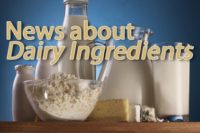Dairy foods and fruit are a fabulous fit for many reasons: Fruit ingredients impart natural sweetness, flavor, color, and a dash of nutrients. As a result of these attributes and the fact that fruit ingredients are “natural,” dairy products containing fruit are popular with consumers. In fact, according to Technomic data, the fruit flavor profile is currently a consumer favorite, up from seventh place in 2009 to second place in 2011.
Superfruit flavors such as acai and pomegranate had their heyday, but traditional fruit flavors are once again the principal palate pleasers—and processors are responding. Innova Market Insights 2012 reported that the top fruit flavors in new U.S. product introductions are strawberry, orange, apple, raspberry, lemon, cherry and blueberry. Consumers who once sought superfruit-containing foods and beverages for their antioxidants have moved on to products containing herbs and spices.
A future flavor trend may be fruit/vegetable blends. Ana Gumabon, director of research and development with California Custom Fruits & Flavors, shared that the company is presenting fruit and vegetable combinations in their innovations for several reasons: vegetables are lower in calories than fruits, certain vegetables provide nutrients not present in fruits, and certain vegetables (red beets, purple sweet potatoes, orange carrots and green spinach) have stronger color pigments than fruits.
So, fruit’s natural sweetness, flavor and color are fruitful for consumers and dairy processors: When dairy foods are appealing and taste delicious, consumers are more likely to get the recommended three servings of dairy every day. But in terms of nutrition, is the dairy industry selling consumers short on fruit ingredients? Consumers are looking for quick and convenient ways to consume more fruit (as well as more vegetables and whole grains) in order to boost their nutrient and fiber consumption. Do dairy products with fruit ingredients deliver?
Some say adding fruit or fruit juice to dairy bestows a health halo. However, consumers may assume these products provide the health benefits of a serving of fruit in addition to the health benefits of dairy. On a recent grocery shopping trip, I searched for dairy foods with whole fruit ingredients and found a few. One brand of cottage cheese that lists fruit as the fourth ingredient contains approximately one tablespoon of finely diced fruit (I measured) in a 4-ounce serving. One brand of yogurt that boasts “2x the fruit of the leading yogurt” lists fruit as the second ingredient and also contains about a tablespoon of fruit pieces in a 4-ounce serving — and it was delicious. Some yogurts and smoothies contain fruit puree — they also were delicious.
Understandably, it’s difficult to include even a quarter-serving of fruit in a single-serve dairy product, especially due to the small size containers. I thought about the new freeze-dried fruit powders that Spanish researchers have created and wondered if these powders will one day be a boon to dairy processors and consumers’ nutrient intake.
For now, my advice to consumers who want to combine the nutritional benefits of fruit in full force with dairy’s nine essential nutrients: Add the fruit yourself.
Ingredients
Do Fruit Ingredients Boost the Healthfulness of Dairy Foods?




